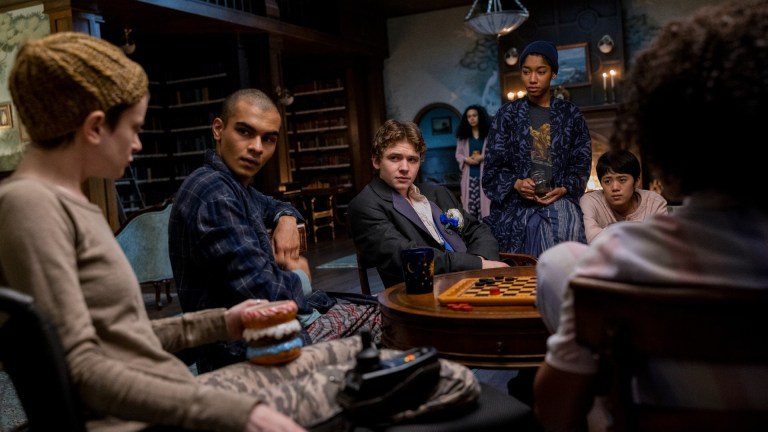The Midnight Club Review: A Rare Flanagan Misfire
Netflix's latest Mike Flanagan horror effort The Midnight Club has a charming YA sensibility but not enough scares.

This article contains no spoilers.
Mike Flanagan has become Netflix’s go-to spooky season purveyor, dealing out annual horror miniseries that serve somewhat as Trojan horses for deep ruminations on life, death, and faith. After The Haunting of Hill House, The Haunting of Bly Manor, and Midnight Mass, Flanagan’s house style has crystalized. A Flanagan joint will have flowery monologues, complicated group dynamics, and harrowing backstories for the central characters that inform the scares being served in the main narrative. Flanagan’s latest outing for Netflix, an adaptation of Christopher Pike’s YA book series The Midnight Club, co-created by Bly Manor co-producer Leah Fong, unfortunately finds Flanagan’s usual tricks feeling stale in this Are You Afraid of the Dark?-meets-The Fault in Our Stars melodrama.
For those like myself who are unfamiliar with the book series, The Midnight Club centers on Ilonka (Iman Benson), a smart high school student with Ivy League aspirations who learns she has terminal cancer. She decides to spend her remaining time at a youth-centered hospice called Brightcliffe. Inside Brightcliffe, the young residents meet nightly to tell scary stories as a means of processing the grim realities of their situations. Over time, Ilonka and the club members unearth information about Brightcliffe’s mysterious past, including other secret societies, occult activity, and a former patient who was supposedly miraculously healed.
Most of the series follows Ilonka as she learns to fit in with the other patients of Brightcliffe, including her headstrong, cynical roommate Anya (Ruth Codd) and love interest Kevin (Igby Rigney), while she also explores Brightcliffe’s history, believing the old mansion may contain a secret which will help her overcome her illness. The rest of the runtime takes an anthology approach, as we see The Midnight Club’s stories play out, with the club members themselves taking on the roles in the tales. Several of the stories told are adapted from Pike’s other novels.
The anthology approach has a predictably hit-or-miss quality, but the format does an excellent job highlighting how important stories and storytelling can be, especially in the face of unfathomable stress or grief, and how stories can help us cope with the feelings we may not be able to express otherwise. That said, when one of the stories does feel compelling and vibrant, like Kevin’s tale of a teenage serial killer, it’s stretched in pieces across three episodes, stalling its momentum. Still, kudos to the team for giving each story a fresh look and feel that fits the story’s genre. For instance, a noir story is given extra oomph by being shot in black and white and given a 4:3 aspect ratio. Still, some of these tales fall completely flat, though sometimes by design, but it’s not as if you’ll be begging to return to the wheel-spinning main narrative.
Obviously a cast full of dying kids feels like a shortcut for emotional resonance, but Flanagan isn’t a surface-level storyteller. The writing really dives deep into complicated, difficult thoughts about death and dying, including clever ruminations on why we use fight terminology when discussing cancer and how mercy can be counterproductive for those staring death in the face. However, similar to Midnight Mass, the frequency in which characters launch into passionate speeches begins to have a numbing effect; by the tenth monologue about what it feels like to know that you’re dying, your eyes can begin to gloss over. Also, the young cast isn’t always able to sell Flanagan’s purple prose.
That said, there are some impressive performances within the teenage cast, especially Codd, who transforms the bitchy Anya from an annoying grouch to the heart of the show. Anya’s character is given so much depth and shading that it almost hurts, as the other characters feel like hollow tropes in comparison. The series eventually gives characters like Spence, a gay AIDS patient played by Chris Sumpter, proper development in the back half of the season, but there are still members of the club that I cannot name after 10 episodes. The adult members of the cast are more uniformly impressive, including Nightmare on Elm Street alum Heather Langenkamp as Brightcliffe’s caring, yet authoritative Dr. Stanton and Flanagan favorite Samantha Sloyan as a friendly neighbor. Many of Flanagan’s past collaborators show up in small roles, and their presence is more than welcome.
One of the series’ biggest issues is the limp scares. Flanagan has appeared to be less interested in scaring his viewers over time, and The Midnight Club is by far his least terrifying offering to date. It almost feels like the show forgets that it was pitched as a horror series and remembers mid-episode, throwing out the same jump scare over and over to appease critics like myself looking for something spooky. Now, maybe the dialed back horror is because this series is purposely playing to a younger audience, but the horror elements truly do come across like an afterthought.
As alluded to before, another complaint is that the main narrative, about Ilonka searching for more info about a past resident that was miraculously sent home, doesn’t feel like it goes anywhere. The mystery does have one big reveal, but viewers will see it coming from a mile away. And unlike Flanagan’s other series, The Midnight Club appears to be planning for a second season, meaning season one ends on a frustratingly incomplete note, with a cliffhanger that will likely leave you scratching your head rather than anxiously anticipating the next season.
As someone that wasn’t aware of this aspect prior to binging, it was an unfortunate development. And while I’m nitpicking, the show goes out of its way to tell viewers its set during the summer of 1995, then has its characters making references to OK Computer and breaking out into group renditions of “Good Riddance (Time of Your Life)” which not only lyrically does not fit the moment on screen, but also was released in 1997. Young viewers likely won’t care, but anyone who was around during the ‘90s will bristle at the inaccuracies and on-the-nose needle drops.
While The Midnight Club has some solid one-off tales within, there’s too much bloat and not enough story to recommend it to anyone beyond fans of the book series or Flanagan faithfuls. There’s a lot of elegant writing about mortality, grief, faith, and love and a couple memorable characters, but its main mystery will likely leave you unmoved and its scares even moreso. Flanagan is still a compelling storyteller but I’m not sure I’ll be attending more meetings of The Midnight Club.
All 10 episodes of The Midnight Club are available to stream on Netflix now.
